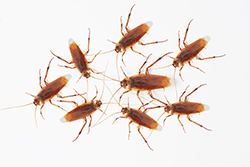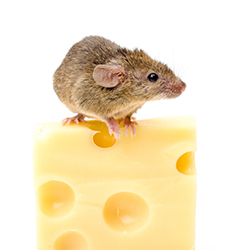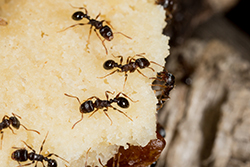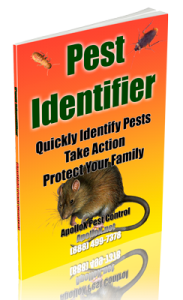If you have ever poured cereal into a bowl then watched with alarm as several pieces began to crawl up the side of the bowl, you may have
already discovered stored product infesting beetles. A variety of food destroying pests, from small insects to mice and rats live and feed on the same foods we do.
Food Destroying Pests: Examples
Cockroaches
 The American cockroach is the household cockroach. They are often found in sewers and basements, around pipes and drains. Cockroaches can spread at least 33 kinds of bacteria, 6 kinds of parasitic worms, and 7 other pathogens. Brownbanded cockroaches prefer warm and dry locations, such as near refrigerator motor housings, on the upper walls of cabinets, and inside pantries, closets, dressers, and furniture in general. The German cockroach is usually found in kitchens (near dishwashers, stoves, and sinks) and in bathrooms of homes.
The American cockroach is the household cockroach. They are often found in sewers and basements, around pipes and drains. Cockroaches can spread at least 33 kinds of bacteria, 6 kinds of parasitic worms, and 7 other pathogens. Brownbanded cockroaches prefer warm and dry locations, such as near refrigerator motor housings, on the upper walls of cabinets, and inside pantries, closets, dressers, and furniture in general. The German cockroach is usually found in kitchens (near dishwashers, stoves, and sinks) and in bathrooms of homes.
Pantry Moths
 A mature Indian meal moth female lays 100 to 300 eggs on food material, either singularly or in groups of twelve to thirty. The Mediterranean Flour Moth can be found in many foods in addition to flour, grain residues, broken kernels and various whole grains. The female moth lays from 116 to 678 small white eggs in accumulations of flour, meal, waste grain, and other food sources. Commonly, the eggs are attached to the food.
A mature Indian meal moth female lays 100 to 300 eggs on food material, either singularly or in groups of twelve to thirty. The Mediterranean Flour Moth can be found in many foods in addition to flour, grain residues, broken kernels and various whole grains. The female moth lays from 116 to 678 small white eggs in accumulations of flour, meal, waste grain, and other food sources. Commonly, the eggs are attached to the food.
Mice
 The deer mouse enters homes through small cracks in windows and doors and are in search of food and warmth. Deer mice damage upholstered furniture, mattresses, clothing, paper, or other materials they find suitable for constructing their nests. Deer mice are a particular concern because they spread hantavirus, which can be deadly to people. The house mouse consumes and contaminates food meant for humans, pets, livestock, or other animals. In addition, they cause considerable damage to structures and property, and they can transmit pathogens that cause diseases such as salmonellosis, a form of food poisoning.
The deer mouse enters homes through small cracks in windows and doors and are in search of food and warmth. Deer mice damage upholstered furniture, mattresses, clothing, paper, or other materials they find suitable for constructing their nests. Deer mice are a particular concern because they spread hantavirus, which can be deadly to people. The house mouse consumes and contaminates food meant for humans, pets, livestock, or other animals. In addition, they cause considerable damage to structures and property, and they can transmit pathogens that cause diseases such as salmonellosis, a form of food poisoning.
Rats
 Norway rats eat and contaminate foodstuffs and animal feed. They also damage containers and packaging materials in which foods and feed are stored. If roof rats are living in the attic of a residence, they can cause considerable damage with their gnawing and nest-building activities. They also damage garden crops and ornamental plantings. Among the diseases roof rats can transmit to humans or livestock are murine typhus, leptospirosis, salmonellosis (food poisoning), and ratbite fever. Plague is a disease that roof rats can carry.
Norway rats eat and contaminate foodstuffs and animal feed. They also damage containers and packaging materials in which foods and feed are stored. If roof rats are living in the attic of a residence, they can cause considerable damage with their gnawing and nest-building activities. They also damage garden crops and ornamental plantings. Among the diseases roof rats can transmit to humans or livestock are murine typhus, leptospirosis, salmonellosis (food poisoning), and ratbite fever. Plague is a disease that roof rats can carry.
Pavement Ants
 Pavement ants feed on a wide variety of food. Sweets, including sugar, nectar, fruits, and syrups are readily taken. Grease, dead insects, and small seeds also are collected and stored in the nest. Nearly any morsel of food that falls to the floor will be consumed.
Pavement ants feed on a wide variety of food. Sweets, including sugar, nectar, fruits, and syrups are readily taken. Grease, dead insects, and small seeds also are collected and stored in the nest. Nearly any morsel of food that falls to the floor will be consumed.
Food Destroying Pests Contaminate Food, Cause Allergies and Spread Disease
Adults of many of these food destroying pests pests fly toward lights and may be found in other rooms or floors quite a distance from your food storage areas. These pests do eat at least a small amount of the food they infest, but their presence, their droppings, cast skins, and certain chemical excretions contaminate much more of the food and sometimes cause allergies in those persons who ingest them.
Get rid of pantry moths. Schedule an appointment with ApolloX today.












Recent Comments